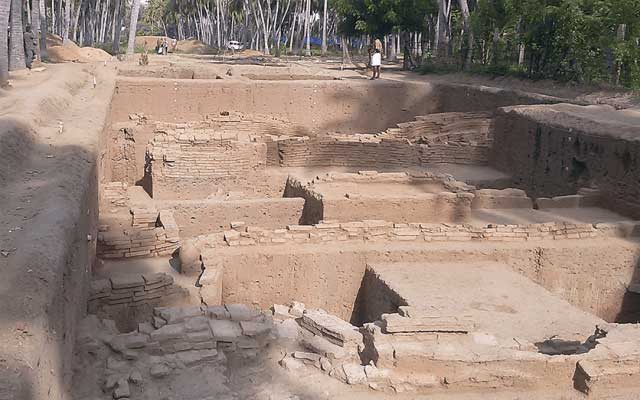
A common Tamil thread could have bound Keeladi with Harappa

The twin riddles of Indology, namely the Indus Valley Civilization and the Vaigai ‘valley civilization’ at Keeladi may not only be interconnected, but could also have a common Dravidian identity. The claim was made by author and bureaucrat R Balakrishnan during the launch of his new book Journey of a civilization: Indus to Vaigai on Monday (December 16).
While the Indus Valley Civilization is said to have stretched from northeast Afghanistan, through Pakistan and into western and northwestern India, between the 3rd and 1st century BC, Balakrishnan says it might have overlapped and shared identity with a similar civilization on the banks on Vaigai down south, that is said to have thrived between the 6th century and the 1st century BC.
Also read: Potsherds in Keeladi site not old as 6th century BC
Drawing parallels between both the civilizations, Balakrishnan, a historian and an archaeology enthusiast said the polity and city planning of the purported civilization along Vaigai and the Indus Valley Civilization have similarities, although they are not exactly co-terminus.
“Sangam texts also talk about the boundary of a civilization along Vaigai stretching till the northwest part of the country, before the Sangam Age,” he said.
While Indus Valley civilization was touted to have introduced the first urban settlements and maritime trade, Sangam texts also glorify maritime trade, celebrate the agro-pastoral foundations and the five landscape-specific settlements of ancient Tamils in the Vaigai civilization.
Journalist and author of Early Indians Tony Joseph who released Balakrishnan’s book, substantiated the latter’s claims about a shared Tamil identity between the two civilizations with examples.
“For instance, the Harappans called sesame as ‘ellu’ which is referred by the same name in Tamil,” Joseph said.
T Udayachandran, principal secretary, Tamil Nadu Archaeology department said Tamil names like Karikalan, Cheran, Murugan and Vanji are said to have roots in the Indus Valley civilization.
“Brahui, a language spoken in Balochistan (parts of which were under the Indus Valley Civilization) shares several common words with Tamil like kal (stone),” said Udayachandran.
Pointing to similarities between the archaeological finds at Harappa and Keeladi, Joseph says seals found in Harappa and finds at Keeladi do not depict wars and battles, unlike those found at Mesopotamia – a sign that the people avoided valorisation of violence.
Also read: Keeladi excavation raises more questions than answers
“In Mesapotamia, the kings and queens were buried with huge treasures and sometimes with their servants to serve them in their afterlife. We cannot find such burials at Harappan sites. It is not because the Harappan didn’t own precious jewels or had servants. It is because they had a different sensibility compared to the Mesopotamians. It is not surprising to find similar sensibilities at the ongoing Keeladi excavations, which neither had burials like the Mesopotamians not flaunted symbols of religion and war,” Joseph said.
“The Journey of a Civilization therefore, is a critical work because it unambiguously and clearly heals away our memory loss, and takes possession of Harappan civilization and claims it as our own,” he added.
“The spatial and temporal gaps between the Indus Valley Civilization and Keeladi cannot deter or discourage the claim that both had,” said Balakrishnan.
Balakrishnan says he was inspired to work on his book when during a visit to a remote village in Koraput district of Odisha in 1988, he stumbled upon the word Tamili etched on a milestone.
“That was the starting point of my interest in archaeology. This is not a structured research. But I have tried to answer some of the questions related to our civilization. This book is my own understanding of prehistory and history,” Balakrishnan said.

